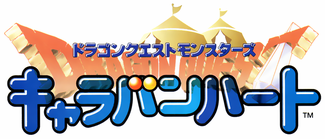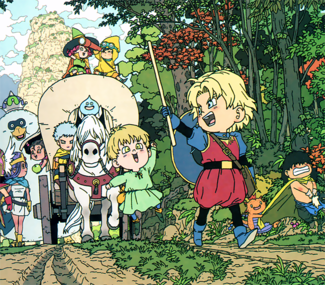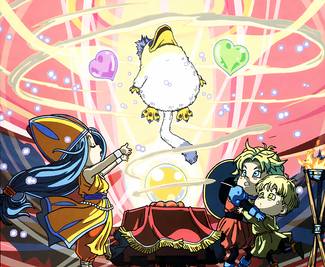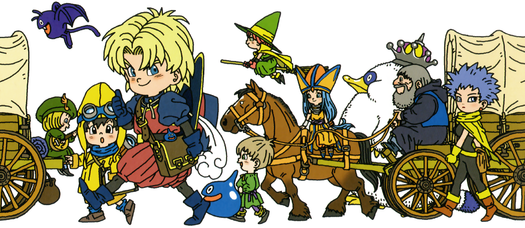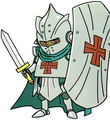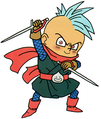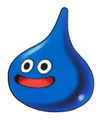Dragon Quest Monsters: Caravan Heart
| Dragon Quest Monsters: Caravan Heart | |
|---|---|
| Developer(s) | TOSE |
| Publisher(s) | Enix |
| Designer(s) | Yuji Horii |
| Artist(s) | Akira Toriyama |
| Series | Dragon Quest Monsters |
| Platform(s) | Game Boy Advance |
| Release date(s) | JP March 29, 2003 |
| Genre(s) | Console role-playing game |
| Mode(s) | Single player |
| Rating(s) | CERO: All Ages |
Dragon Quest Monsters: Caravan Heart is a 2003 role-playing game in the Dragon Quest series, developed for the Game Boy Advance. It is the third installment in the Dragon Quest Monsters series.
The game was never released outside of Japan, though a fan-translation patch has been made.
Story[edit]
The game puts you in the shoes of a young Kiefer from Dragon Quest VII: Fragments of the Forgotten Past in the same way the first Monsters game had as its main character a young Terry from Dragon Quest VI: Realms of Revelation.
Up to his usual mischief, nine-year-old Kiefer upsets his father, the King of Gran Estard, more than ever before and flees to his room in hopes of escaping his punishment. Hiding inside his dresser, Kiefer hears a voice call out to him and wanders out to an odd silence and the presence of a Teleportal in his room. Once stepping in, Kiefer finds himself in Torland from Dragon Quest II: Luminaries of the Legendary Line and must no sooner assume the role of a caravan leader in order to help a boy named Luin find a cure for his sick parents.
Characters[edit]
- Kiefer
- Foz
- Randall - a Mapper.
- Alex - a Warrior.
- Deckson - a Cleric.
- Alisa - a Mage.
- Ripple - a Dancer.
- Ann - a Martial Artist.
- Slalon - a dark blue Slime, the leader of the caravan until Kiefer arrives.
- Luin - the leader of the caravan until he passes out and Slalon takes over.
Features[edit]
Caravan[edit]
The player's overall party is referred to as a caravan, a collection of wagons, tents, people, monsters, and supplies. The camp that the caravan forms acts as a mobile base for the player throughout the course of the game, options being available for moving around the caravan and camp in order to exercise some strategy while venturing about the world. The camp itself contains an assortment of different tents that vary and increase depending on caravan members and the spot the camp has been set. It is undoubtedly the most visited spot throughout the game, containing essentials such as a church, a lady that refills ration, and a tent where monsters can be reformed. Whenever a WarpWing is used it will return the player to the camp.
Wagons[edit]
A staple of the Zenithia Trilogy, the wagon, makes a return in Caravan Heart as a central part of forming a team. The player will start out with one wagon in their caravan and can obtain two more as the game progresses, each wagon having to be assigned a guard monster and up to four humans depending on the individual weight of monster and person alike and the weight capacity of the wagon in question. The monster will be able to act each turn while the caravan members in the wagon will act according to the order they were placed in, with the fifth turn of a fight (and any preceding turns that caravan members couldn't act) being used by the wagon to get organized before the caravan members will repeat their actions where repetition is applicable. If a guard monster for a particular wagon gets KOed, or if the wagon has no guard monster, the caravan members will be unable to act in battle.
Food[edit]
When moving through the over-world or within dungeons, the player will steadily consume their rations, indicated by a number in the upper-right corner of the screen. The amount of food the player and their caravan can hold increases in intervals determined by how much the player has walked, essentially acting as a separate leveling mechanic. The food indicator will turn green when rations start running low, and if it hits 0 the HP of the guard monsters will decrease very rapidly when moving about, so it is wise to keep the indicator as high as possible by either regularly restocking at the camp or shops or by having items on hand that can replenish the ration supply, such as apples and box lunches. The rate which rations are consumed can be determined by several factors, such as the terrain being crossed and whether or not the camp is being moved along with the player.
Battles[edit]
Unlike the other games in the Monsters sub-series, Caravan Heart uses a battle system akin to that of the traditional games where enemies can appear in individual groups well-exceeding the normal 3-on-3 battles, though the player is still restricted to as many as three acting monsters on their side. With this system in place many moves have been given their traditional traits such as Firebal (Sizz) being able to hit groups and Icebolt (Crack) being able to only hit one monster but significantly more as it advances. Additionally, monsters can only have six moves each as opposed to the previous 8, likely due to balance out with acting caravan members that have techniques that mimic many attacks. With the odds in numbers often being against the player and strategizing more strict, Caravan Heart can prove to be a more challenging game when compared to others in the sub-series.
Monster Hearts[edit]
Instead of holding a large stock of available monsters the player will only have a few monsters to choose from throughout the entire course of the game and will be able to collect monster hearts instead of the monsters themselves. These hearts are central to the game's spin on the old breeding system and are thus one of the most important aspects of the game.
Reform / Tenshin System[edit]
Caravan Heart replaces the breeding system from the previous games with the reform system (tenshin system when taken directly from the Japanese Version). Instead of two monsters being used to create a new one, a single monster has two monster hearts applied to it which are then used to reform it. While using three ingredients may be more complicated than using two, the system itself has more benefits as the reformed monster will not forget any of the moves it learned, retaining them even in their advanced states, and the stat loss isn't nearly as severe as it could be with breeding.
Caravan Members[edit]
Nearly as important as the guard monsters are the people that ride in the wagons they guard, the caravan members. These individuals are often callbacks to classes from previous games, some being the classes outright, while others fulfill roles specific to Caravan Heart. Depending on what class they are, the caravan members can have significant effect in battle, on the field, and within the camp itself. The 21 different members available throughout the game are:
- Warrior
- Martial Artist
- Knight
- Dancer
- Troubadour
- Fencer
- Priest
- Medic
- Mage
- Seer
- Merchant
- Thief
- Mapper
- Hunter
- Fisher
- Cook
- Tamer
- Gadabout
- Metal Hunter
- Gambler
- Rebirther
Additionally, if more than one of the same kind of member is put in a wagon their power will increase, and if the wagon if full of that particular character then a special move can be used in battle. It is also possible to find advanced forms of the individual types that can mimic the actions of two or three of the same type, but without using up as much space. Members cannot change their type, nor can they advance their own type, so it will become necessary to remove members as new, superior ones are found. Occasionally, when a caravan member is let go they will leave behind a heart based on their class which can be used in reforming to boost a stat by a certain amount.
Random Encounters[edit]
As the player travels Torland, they will not only run into monster fights, but an assortment of events as well. The player can be given the opportunity to obtain items, refill their rations, and even earn monster hearts by helping out vulnerable monsters (assuming they have a caravan member capable of helping the monster), though bad events can also occur, such as being ambushed by monsters out for food, or thieves out for gold.
Saving[edit]
Yet another tradition brought back is the necessity to save at churches instead of the ability to save anywhere, as in the previous two Monsters games and the subsequent Joker games (provided one was in a safe spot or had a bookmark).
